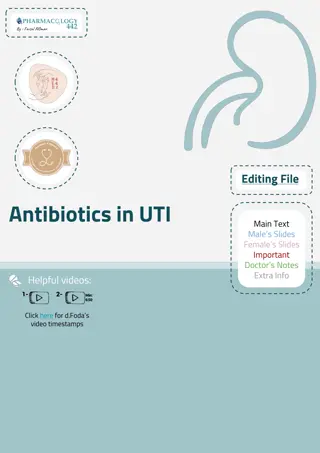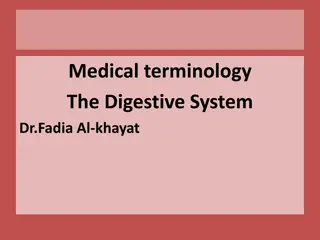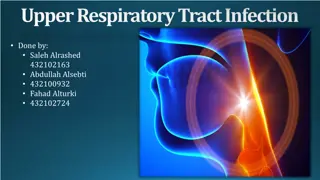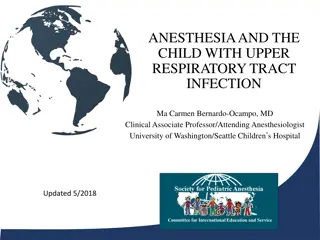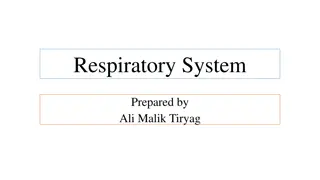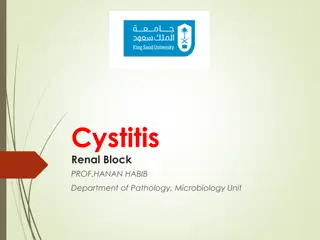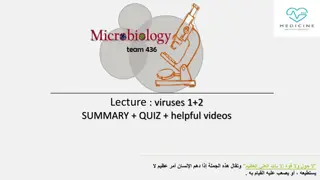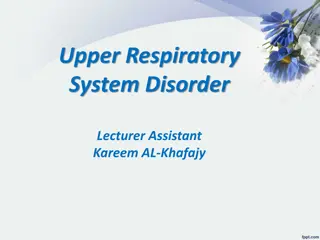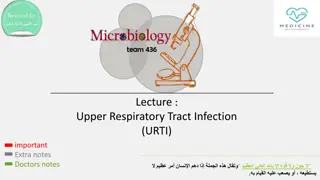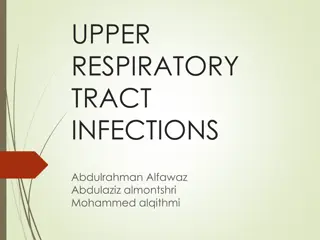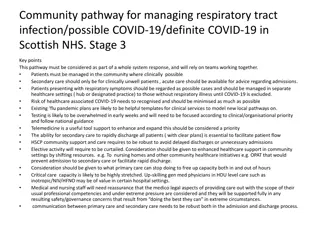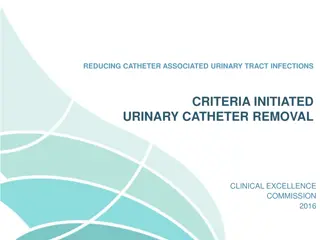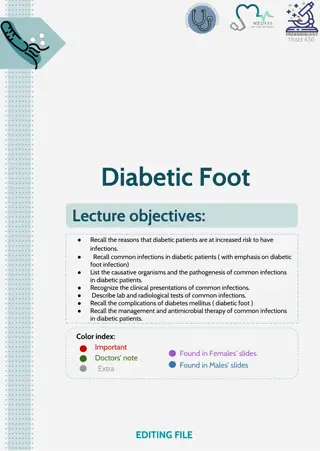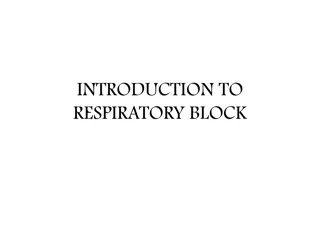Understanding Nontuberculous Mycobacteria Infections in Cystic Fibrosis
Nontuberculous mycobacteria (NTM) infections present a significant challenge in individuals with cystic fibrosis (CF). These infections are caused by over 200 species of atypical mycobacteria found in various environments. The CF-ID Clinic plays a crucial role in managing patients with multi-drug re
2 views • 25 slides
Understanding Urinary Tract Infections (UTIs) and Antibiotics: A Comprehensive Overview
Urinary Tract Infections (UTIs) are a common issue, more prevalent in women, with causes ranging from poor hygiene to underlying health conditions. The content delves into the classification of UTIs, their main causes, and bacteria responsible for infections. It also covers the complications of UTIs
0 views • 12 slides
Anaerobic Bacterial Infections: Overview and Clinical Implications
Anaerobic bacterial infections are caused by bacteria that do not require oxygen for growth, posing challenges in diagnosis and treatment. This article delves into the types of anaerobic bacteria, their role in human infections, and common clinical presentations such as abscess formation. Gram-negat
2 views • 24 slides
Understanding the Digestive System: Medical Terminology Overview
The digestive system, comprising the gastrointestinal tract (GIT) and accessory organs, plays a vital role in digestion. From the upper GI tract (oral cavity, esophagus, stomach) to the lower GI tract (small and large intestines), each part has specific functions. Understanding salivary glands and c
0 views • 18 slides
Overview of Genitourinary Tract Infections and STIs by Prof. Dr. Mete Kılcıler
Genitourinary Tract Infections and Sexually Transmitted Infections (STIs) are common conditions affecting both men and women. This article, presented by Prof. Dr. Mete Kılcıler from the Department of Urology at Bahçeşehir University School of Medicine, delves into the various aspects of UTIs, in
2 views • 47 slides
Virus Entry Mechanisms: Understanding Pathogenesis and Spread
Exploring the diverse ways viruses enter the body through various routes such as respiratory tract, oropharynx, skin, genitourinary tract, and eyes, shedding light on the steps of the virus life cycle shaping pathogenesis. Viral diseases result from the intricate interaction between viral and host f
4 views • 20 slides
Differentiating between Viral and Bacterial Infections in Upper Respiratory Tract
Understanding the distinction between viral and bacterial upper respiratory tract infections is crucial for effective management and treatment. This article discusses key differences in symptoms, diagnostic methods, and treatment approaches to aid in accurate differentiation between the two types of
2 views • 87 slides
Anesthesia and the Child with Upper Respiratory Tract Infection
This presentation discusses the challenges and recommendations for anesthetic management of children with upper respiratory tract infections (URIs). It covers the etiology, bronchoconstriction causes, adverse effects, and current guidelines for anesthesia in these cases. The impact of URIs on emerge
0 views • 52 slides
Understanding Host Defense Mechanisms Against Infection
Host defense mechanisms safeguard the body from pathogens through various strategies such as intact skin, mucous membranes, nonspecific immune responses like phagocytic cells, and specific immune responses involving antibodies and lymphocytes. Key protective barriers include the skin, eyes, digestiv
3 views • 16 slides
Understanding the Normal Microbial Flora of the Human Body
The normal microbial flora, also known as the indigenous microbiota, inhabit various areas of the human body such as the gastrointestinal tract, respiratory tract, genitourinary tract, and skin. They play a crucial role in maintaining health and can re-establish themselves when disturbed. While resi
0 views • 22 slides
Understanding the Treatment of Respiratory Tract Infections: Antibiotics and Management
This lecture covers the classification of respiratory tract infections and the antibiotics commonly used to treat them. It highlights the types of infections caused by viruses and bacteria, along with their respective treatments. The mechanism of action and pharmacokinetics of antibiotics, such as p
0 views • 7 slides
Understanding Acute Respiratory Infections (ARI): Symptoms, Classification, and Transmission
Acute Respiratory Infections (ARI), characterized by sudden onset respiratory symptoms affecting the respiratory system from nose to alveoli, are a complex group of diseases caused by various agents. Symptoms include pain in the sinuses, nasal congestion, fatigue, sinusitis, coughing, and more. The
0 views • 16 slides
Understanding Urinary Tract Infections During Pregnancy
Urinary tract infections are common bacterial infections during pregnancy, with asymptomatic bacteriuria being prevalent. If left untreated, asymptomatic bacteriuria can lead to symptomatic infection, but proper treatment with antimicrobial agents can prevent complications. Treatment options include
3 views • 26 slides
Understanding the Respiratory System: An Overview
The respiratory system, consisting of the upper and lower respiratory tracts, is responsible for ventilation and gas exchange. Learn about the anatomy, common symptoms like dyspnea and cough, and how the system functions anatomically and physiologically. Understanding these aspects can help in recog
0 views • 15 slides
Understanding Cystitis: Causes, Symptoms, and Management
Cystitis is a common urinary tract infection affecting both men and women, characterized by inflammation of the bladder mucosa. This article covers the definition, pathogenesis, risk factors, causative organisms, types, diagnostic methods, and treatment options for cystitis, emphasizing the importan
0 views • 24 slides
Viral Infections of the Respiratory System Lecture Summary & Quiz
This lecture covers viral infections of the respiratory system, focusing on Avian flu, Influenza Virus, Respiratory Syncytial Virus, Human metapneumovirus, Parainfluenza viruses, Measles, and Mumps virus. It includes information on the structure, symptoms, lab diagnosis, treatment, and prevention of
0 views • 11 slides
Understanding Upper Respiratory System Disorders in Children
Anatomy of the child's respiratory tract, common cold (acute nasopharyngitis), clinical manifestations, treatment and nursing care are discussed in detail, emphasizing the importance of differentiating between various childhood contagious diseases and allergic rhinitis. The content highlights the sy
0 views • 26 slides
Understanding Upper Respiratory Tract Infections (URTI) in Children
This informative lecture covers the epidemiology, clinical presentations, common etiological agents, and laboratory diagnosis of upper respiratory tract infections (URTI) in children. Topics discussed include pharyngitis, diphtheria, epiglottitis, pertussis, acute otitis media, sinusitis, and other
0 views • 16 slides
Upper Respiratory Tract Infections: Clinical Features and Management
This presentation covers the differentiation between viral and bacterial infections, clinical features and management of sore throat, sinusitis including allergic rhinitis, otitis media in children, and modifying help-seeking behavior in patients with flu illness. Pre-test questions are also include
0 views • 75 slides
Sniff Nasal Inspiratory Pressure (SNIP): Assessing Respiratory Muscle Strength
SNIP is a sensitive non-invasive test that measures inspiratory muscle strength by assessing nasal pressures during a sniff maneuver. It is a valuable tool for early detection of respiratory muscle decline, providing insights into potential threats like hypercapnic respiratory failure, impaired coug
0 views • 11 slides
Neonatal Respiratory Support Study Overview
This study focuses on evaluating the primary outcomes of length of hospital stay post-birth and incidence of severe respiratory failure in infants receiving respiratory support. Detailed logs are maintained daily until the infant is off respiratory support or discharged. The study is funded by NIHR.
0 views • 19 slides
Overview of Gram-Negative Enteric Bacilli
Gram-negative bacilli are a diverse group of bacteria, including enteric and non-enteric bacilli. Common characteristics include being aerobic or facultative anaerobes, fermenting glucose, and being part of the normal flora of the human and animal gastrointestinal tract. Escherichia coli (E. coli) i
0 views • 27 slides
Anesthesia and Upper Respiratory Tract Infections in Children
This presentation discusses the etiology, differential diagnoses, and management of upper respiratory tract infections (URIs) in children undergoing anesthesia. It covers causes of bronchoconstriction, adverse respiratory effects of URIs, and current anesthetic recommendations. The content emphasize
0 views • 52 slides
Comprehensive Pathway for Managing Respiratory Tract Infections and COVID-19 in Scottish NHS
Consideration of a community-based approach to managing respiratory infections and potential/confirmed COVID-19 cases is crucial in the Scottish NHS. This pathway emphasizes the collaboration between teams, appropriate patient management in healthcare settings, minimization of healthcare-associated
0 views • 15 slides
Understanding the Control of Breathing and Respiratory Rhythm
The content delves into the intricacies of the control of breathing, emphasizing the role of the medulla oblongata in regulating respiratory activity. It explores factors modifying breathing patterns, respiratory consequences of changing PO2, PCO2, and pH, and the functions of central and peripheral
0 views • 16 slides
Understanding the Respiratory System Components and Functions
The respiratory system consists of two primary subdivisions: the Air Conducting portion and the Respiratory portion. The Air Conducting portion includes nasal cavity, naso-pharynx, larynx, trachea, bronchi, bronchioles, and terminal bronchioles, providing a pathway to and from the lungs while condit
0 views • 12 slides
Understanding Respiratory Tract Infections: Causes and Prevention
Respiratory tract infections are commonly caused by viruses, bacteria, rickettsia, and fungi, leading to various health issues. These infections can be transmitted through droplets, droplet nuclei, and dust, emphasizing the importance of maintaining respiratory health through specific and non-specif
0 views • 34 slides
Understanding Nasal Cavity Histology and Respiratory Structures
The detailed information provided covers the histological structures of the nasal cavity, including the vestibule, respiratory mucosa, nasal septum, olfactory mucosa, and paranasal sinuses. It also delves into the microscopic structures of the wall of the trachea and primary bronchi. The respiratory
0 views • 11 slides
Respiratory Tract Anatomy Overview
The respiratory tract anatomy includes various structures like mucosa, submucosa, and adventitia in the trachea, bronchi, bronchioles, and terminal bronchioles. Each component has specific compositions and functions, ranging from respiratory epithelium to smooth muscle layers. The images provide a v
0 views • 15 slides
Understanding Equine Influenza: An Overview of Respiratory Tract Infections in Horses
Equine influenza is a contagious upper respiratory infection in horses caused by influenza viruses. This article covers the anatomy of the equine respiratory tract, signs, diagnosis, treatment, prevention, and prognosis of equine influenza. It also discusses the histological structure of the respira
0 views • 18 slides
Understanding Urinary Tract Wellness and Illness with Prof. Dr. Rabea M. Ali
The urinary system plays a vital role in our overall health by regulating blood volume, composition, pressure, pH balance, and more. Keeping the urinary tract healthy involves proper hydration, diet choices, and lifestyle habits. Foods like berries, yogurt, garlic, and antioxidants can promote urina
0 views • 41 slides
Strategies for Preventing Catheter-Associated Urinary Tract Infections
Catheter-associated urinary tract infections are a common healthcare-associated infection, with 80% of hospitalized patients experiencing a urinary tract infection. This article provides guidelines for preventing CAUTIs, such as only catheterizing patients when necessary, maintaining asepsis, practi
0 views • 20 slides
Understanding Viral Infections of the Respiratory System
Respiratory viral infections are common and primarily caused by viruses, leading to morbidity and time off work. They can range from mild upper respiratory tract infections to severe lower respiratory tract infections like pneumonia. Various viruses like influenza, parainfluenza, respiratory syncyti
0 views • 23 slides
Pediatric Respiratory Infections: An Overview of Cases and Physiology
This review delves into selected cases of respiratory infections in children presented by Dr. David L. Smith, focusing on the anatomical and physiological aspects of the pediatric airway and respiratory system. It discusses respiratory failure in infants and small children, metabolic demands, cyanos
0 views • 49 slides
Understanding Lower Genital Tract Infections: Causes, Symptoms, and Treatment
Lower genital tract infections encompass conditions like vulvitis, vaginitis, and cervicitis, with causes ranging from irritants to infections. Symptoms include itching, discharge, and swelling. Treatment involves identifying and addressing the underlying cause, whether infectious or non-infectious,
0 views • 43 slides
Understanding Diabetic Foot Infections and Associated Risks
Diabetic patients are prone to infections, significantly impacting morbidity and mortality rates. Increased infection risk is due to both host-related and organism-related factors. Common infections in diabetic patients include skin and soft tissue infections, diabetic foot infections, respiratory t
0 views • 14 slides
Preventing Catheter-Associated Urinary Tract Infections
This presentation covers the prevention of catheter-associated urinary tract infections (CAUTIs) in healthcare settings. It highlights the significance of urinary tract infections, risk factors, preventive measures, and common microbiology involved. Key topics include the importance of urine collect
0 views • 34 slides
Understanding the Respiratory System: An Overview
The respiratory system comprises the upper and lower respiratory tracts, responsible for air movement and gas exchange. It relies on the cardiovascular system for proper blood flow. The anatomy involves structures in the upper and lower tracts, with common symptoms like dyspnea and cough indicating
0 views • 20 slides
Understanding Respiratory System Terminology and Disorders
Explore the terminology and components of the respiratory system including the upper and lower respiratory tract, respiration process, word roots, and common respiratory disorders. Learn the meanings of terms like apnoea, dyspnoea, pneumonia, and more. Enhance your knowledge of respiratory health an
0 views • 12 slides
Comprehensive Overview of Respiratory Block for Medical Students
This respiratory block introduces students to the anatomy, histology, muscles involved in respiration, embryology, radiological anatomy, and management of respiratory disorders. It covers topics like the nasal cavity, pharynx, larynx, trachea, bronchi, lungs, pleura, bronchial tree, and mediastinum.
0 views • 23 slides

